

Center for Excellence in Learning and Teaching. Introduction to Bloom’s Taxonomy – Niall McNulty. Benjamin Bloom: the man who changed education Get the Bloom’s Digital Taxonomy guide from Amazon.

This e-book is a practical guide for teachers on how to use Bloom’s taxonomy in a digital classroom setting. An introduction is provided to the Bloom’s taxonomy framework and its adaption for use in a digital environment, with each level discussed and a digital activity suggested that teachers could use with their students. Benjamin Samuel Bloom (February 21, 1913 – September 13, 1999) was an American educational psychologist who examined and then restructured the way teaching should be approached, to maximise learners’ performance. His book, The Taxonomy of Educational Objectives: The Classification of Educational Goals (1956), set out a series of learning objectives that became known as Bloom’s taxonomy. Bloom’s taxonomy: what is it, and how is it used? Bloom’s taxonomy is a multi-layered model for encouraging learning by progressing through six levels of increasing complexity.
Taken from: PCS 2nd grade [licensed for non-commercial use only] / Revised Bloom's Taxonomy. Merrill’s first principles of instruction. Glossary of Curriculum Terminology. Technical Notes. History of-educational-technology-timeline. Media and Information Literacy. People across the world are witnessing a dramatic increase in access to information and communication.
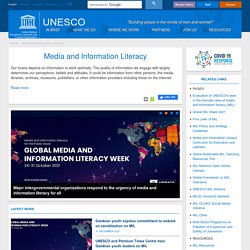
While some people are starved for information, others are flooded with print, broadcast and digital content. Media and Information Literacy (MIL) provides answers to the questions that we all ask ourselves at some point. How can we access, search, critically assess, use and contribute content wisely, both online and offline? What are our rights online and offline? What are the ethical issues surrounding the access and use of information? Through capacity-building resources, such as curricula development, policy guidelines and articulation, and assessment framework, UNESCO supports the development of MIL competencies among people. Information processing. Michael Orey Department of Educational Psychology and Instructional Technology, University of Georgia Review of Information Processing Introduction Figure 1.
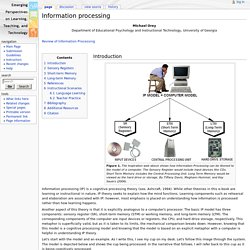
The Inspiration web above shows how Information Processing can be likened to the model of a computer. The Sensory Register would include input devices like CDs. Information processing (IP) is a cognitive processing theory (see, Ashcraft, 1994). Another aspect of this theory is that it is explicitly analogous to a computer's processor. Let's start with the model and an example. Caption: The illustration above represents my coffee cup example.
Sensory Registers The best understood of the sensory registers (SRs) are for hearing (echoic) and seeing (iconic). Short-term Memory Short-term memory (STM) is also known as working memory, and is where consciousness exists. STM is where the world meets what is already known, and where thinking is done. Long-term Memory. Emerging Perspectives on Learning, Teaching and Technology. First Principles of Instruction – M David Merrill. Merrill, M.
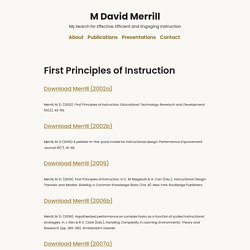
D. (2002). First Principles of Instruction. Educational Technology Research and Development. 50(3), 43-59. Merrill, M. D (2006) A pebble-in-the-pond model for instructional design. Nine events of instruction. 1 Definition "Nine events of instruction" is an instructional design model put together by Gagne.
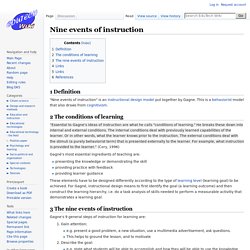
This is a behaviorist model that also draws from cognitivism. 2 The conditions of learning “Essential to Gagne's ideas of instruction are what he calls "conditions of learning. " He breaks these down into internal and external conditions. Gagné's most essential ingrediants of teaching are: presenting the knowledge or demonstrating the skillproviding practice with feedbackproviding learner guidance These elements have to be designed differently according to the type of learning level (learning goal) to be achieved. Firstprinciplesbymerrill. ACT-R » Publications & Models. Merrill’s first principles of instruction. First Principles of Instruction – M David Merrill. Presentations – M David Merrill. If your organization would like to schedule a live or online presentation or discussion with Dr.
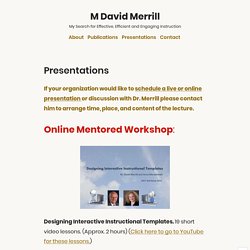
Merrill please contact him to arrange time, place, and content of the lecture. Online Mentored Workshop: Designing Interactive Instructional Templates. 19 short video lessons. (Approx. 2 hours) (Click here to go to YouTube for these lessons.) Workshop: These video lessons are also available as a mentored workshop that includes assignments to accompany the video lessons. Online Mentored Course: Introduction to Dr. First Principles of Instruction Course This is a studio course, meaning that learning is by doing.
Objective: You will design a problem-centered lesson, module or short course of instruction based on First Principles of Instruction. The course includes 8 instructional modules and 6 Instructional Design Assignments plus links to additional resources. Interview Gary Morrison interviews Dave Merrill (54 minutes Download) Presentations Merrill on Instructional Design (6 minutes Download) Merrill’s first principles of instruction.